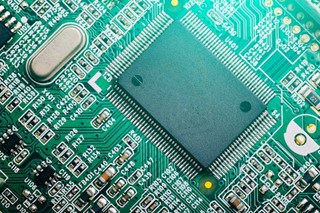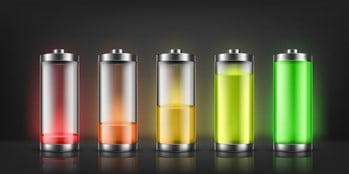SYSTEM LEVEL BMS
The system control function of every Lithium-ion battery pack is the Battery Management System (BMS). The BMS is a custom Printed Circuit Board Assembly (PCBA) with mandatory and optional features to protect the battery pack and the mobile device.
The BMS provides the intelligence of the system for typical or common functions. These functions include protection circuitry, thermal sensors, fuel gauging to predict run time, serial data communications bus, state-of-charge indication for the device users. Advanced features implemented in the BMS may include encryption (to authenticate with the mobile device), cell balancing for higher voltage batteries, integrated charging, and battery heater control.

Example of main processor on BMS
Active BMS circuits are necessary to ensure that the Lithium-ion cells are kept in a stable condition. The primary BMS protection functions shut off charging or discharging during over-current, over-voltage, under-voltage, over-temperature, and under-temperature conditions. Usually, this BMS is a custom designed/manufactured to keep the power output (i.e. Volts, Amps) within strict operating ranges. The BMS circuitry will use one or more thermal sensors to disconnect the cells at a specified temperature and prevent thermal runaway and overheating.
In addition to the mandatory protection features supported by most BMS’s, optional features can be embedded into a BMS for better operational performance and user experience. These features include;
Fuel Gauge, Serial Communications, and LEDs

Fuel gauging is common with many mobile device
The BMS can communicate the state-of-charge with the mobile device and charger via an SMBus, I2C, HDQ, or CANBus. Additionally, the fuel gauge can support an LED display on the battery pack. The LED can provide the device user with information about the battery pack status, including remaining runtime, charge time and a warning of low power. Mobile Power Solutions (MPS) has extensive experience with fuel gauges from Texas Instruments (TI), the leading supplier of BMS electronics and fuel gauges (including the popular Impedance Track Line).
Embedded Heater Control
Aerospace applications require battery operation down to -60 degrees C, while Lithium-ion cells comfortably operate at -20 to + 60 degrees C. To meet this requirement, a heater can be embedded within the battery pack to maintain the cell temperature or warms the cells prior to use. The embedded heater can be powered by the main cells within the pack, or an external source such as a solar array. Embedded heaters can heat cells, reduce electrolyte viscosity, and reduce voltage droop prior to use. The BMS, combined with input from thermal sensors, can control when the cells should receive external heat.
Cell Balancing for High Voltages
For higher voltage battery packs, the benefits of cell balancing implemented on the BMS include maximized run time with each cycle and increased duty cycles throughout pack life. During charging and discharging, cell balancing technology moves energy dynamically from cell to cell with very high efficiency, and does not waste excess energy as heat during the energy transfer process.
USB-C Charging

Example of typical, cost-effective USB-C charger
We have a proliferation of external USB-C chargers and rapid adoption of USB-C as the standard charging interface for mobile devices. Subsequently, many OEM’s are opting to use existing commercial chargers to charge their mobile devices and integrated batteries. The USB-C standard specifies a minimum of 3 Amps current at 5 V (i.e. 15 Watts) and a maximum of 5 Amps current at 20 (i.e. 100 Watts). Voltage increments at 5 V, 9 V, 15 V and 20 V. This wide range of power delivery addresses many of the handheld and mobile power charging requirements.
Integrated Charging
Battery packs can have the charger electronics embedded within the battery pack (rather than the mobile device or an external charging bay). The embedded charging electronics charge the battery pack while the mobile device is connected to AC power. Embedded chargers can use either linear or switching charging circuits. This approach simplifies the mobile device design, as the OEM can ignore the complexity of charge control electronics and external accessories like charging bays/docks/cradles.
Authentication with Encryption

Mobile Devices can authenticate batteries to prevent use of unauthorized batteries
Counterfeit batteries can violate both mechanical and electrical safety requirements defined by the OEM, posing a safety risk for the device user. Adding simple and effective authentication technology to the BMS and mobile device ensures that only approved batteries will power the mobile device. CRC, SHA-1, or HMAC algorithms can be used as authentication schemes.


